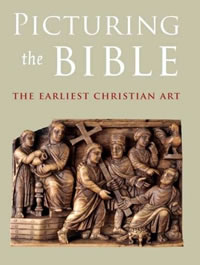Book Notes
 Jeffrey Spier, editor, Picturing the Bible; The Earliest Christian Art (New Haven: Yale University Press in association with the Kimbell Art Museum, 2007), 309pp.
Jeffrey Spier, editor, Picturing the Bible; The Earliest Christian Art (New Haven: Yale University Press in association with the Kimbell Art Museum, 2007), 309pp.
This gorgeous and hefty volume looks like a coffee table book, but it's a book to savor page by page for both its scholarly texts and spectacular images (263 color and 40 black and white). The book was published in conjunction with an exhibition by the same name that was conceived and organized by Jeffrey Spier for the Kimbell Art Museum in Fort Worth, Texas. The exhibit drew upon the collaboration of lenders from nine countries and forty-one private and museum collections.
In the first half of the book six scholars write one chapter each on various aspects of the earliest Christian art through the fifth and sixth centuries. Spier explains how the early Jesus movement first expressed itself in visual forms. Art and architecture flourished in classical Greece and Rome, of course, but "the Christians were slow to express their religious beliefs pictorially, and no churches, decorated tombs, nor indeed Christian works of art of any kind datable before the third century are known." This might have been because the earliest Christians were a persecuted and illicit sect comprised largely of people from lower socio-economic classes. They also inherited Judaism's ambivalence toward art rooted in the prohibition against graven images in Exodus 20:4.
Around the year 200, "purely Christian images began to appear." The forty catacombs in and around Rome, along with the discovery of a house church at Dura Europos in Syria dated to 240 AD, show how the earliest Christian art was not merely decorative but intentionally devotional; its purpose was not "objective beauty" but an "expression of faith." In the first decades of the third century, genuine Christian art appears on seal rings, tombs, clay lamps, engraved gems, and in one instance a marble statuette. A hundred years after that, Christian art adorns belt buckles and Bible covers, plates and coins, intricate mosaics and ornate crosses (see Spier, pp. 1–23). Christian art under Constantine changed radically as images became "imperialized."
The earliest Christian writers didn't say much about art and images, and Spier believes that their hostility toward visual representations has been exaggerated. Most of early Christian art drew upon well-known Bible texts like Noah, Daniel in the lion's den, Moses, Jonah, Adam and Eve, and Abraham. In perhaps the earliest textual reference to Christian art, Clement of Alexandria (150–215) writes that Christians could also borrow pagan symbols as long as they were appropriate. Swords and bows would be inappropriate, he said, because they signaled war and violence, but a dove was suitable, said Clement, "since we follow peace." The volume stops chronologically short of the iconographic controversy.
The last half of the book is a catalogue of color photographs (pp 171–287) which, in effect, place the exhibit into your own hands. Christians identify themselves as people of the Book who worship the Word made flesh. It took a while, but Christians also became people of images, and in those images they expressed their faith as much as they did in words.


